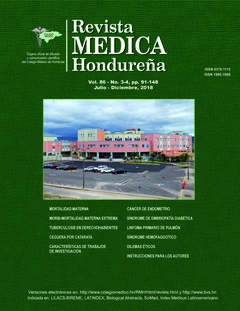Síndrome de embriopatía diabética. Reporte de caso.
DOI:
https://doi.org/10.5377/rmh.v86i3-4.12176Palabras clave:
Anomalías Congénitas, Diabetes Gestacional, Embriología, Hemoglobina A Glucosilada, HiperglucemiaResumen
Antecedentes. Las malformaciones congénitas producidas por la diabetes materna constituyen un síndrome conocido como «embriopatía diabética». Los defectos se asocian a diabetes pregestacional, tipo 1 ó 2. Su patogénesis no está totalmente esclarecida pero la hiperglicemia parece ser el estímulo intrauterino más importante, favoreciendo producción de radicales libres y otras condiciones adversas para la implantación y desarrollo embrionario/fetal. Descripción del caso. Presentamos caso de gestante multípara, procedente de Tegucigalpa, M.D.C, antecedente de diabetes mellitus tipo 2, hipotiroidismo y obesidad grado I, historia gineco-obstétrica: G:3, C:2, A:1, HV:1, HM:1, 6 controles prenatales, con embarazo de 30.6 SG X FUM. Acude a control prenatal, realizándose ultrasonido obstétrico que mostró raquisquisis con hidrocefalia severa y tendencia al macrocráneo, pie equinovaro bilateral y polihidramnios (ILA 21.7cc). Paciente refirió aproximadamente 10 contracciones esporádicas en 24 hrs. Examen físico: GO: cérvix dilatado 2 cm, B: 50% AP: -3, membranas íntegras, cefálico. Es ingresada con plan de cesárea más OTB obteniendo RN con múltiples malformaciones congénitas (defectos del tubo neural, estructuras craneofaciales, y óseas). Se ingresó a unidad de cuidados intermedios, realizándose USG transfontanelar que reportó hidrocefalia severa y por la presencia de mielomeningocele, se sospechó Arnold Chiari tipo II. Se realizó mieloplastía con técnica habitual sin complicaciones, paciente permaneció estable hasta el momento de su egreso hospitalario. Conclusión/recomendación. Niveles de HbA1c en el primer trimestre ≥7% o Glucosa basal >120mg/dl se han asociado al desarrollo de malformaciones. Es importante un estricto control glicémico preconcepcional para disminuir la incidencia de malformaciones asociadas a hiperglicemia en el embarazo.
Descargas
468




